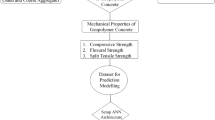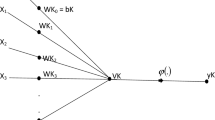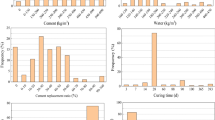Abstract
This research was to study the chloride penetration resistance of normal (W/B of 0.80, 0.62, 0.48) and high (W/B of 0.41, 0.35, 0.30) strength concretes containing ground pozzolans such as fly ash, bottom ash and rice husk ash using the rapid chloride penetration test and the immersion test methods. Furthermore, on the basis of this experimental data, an artificial neural network technique is carried out to derive an explicit artificial neural network formulation for the prediction of chloride permeability as a function of six input parameters: water to binder ratio, percent replacement, testing ages, pozzolans types, aggregate to cement ratio and the actual compressive strength. To verify the model, linear and non-linear regression equations are carried out and compared with the proposed artificial neural network prediction model. The results indicate that the incorporation of ground fly ash, ground bottom ash and ground rice husk ash substantially improve the workability and chloride permeability. The artificial neural network models have more accurate and precise prediction than linear and non-linear regression technique. Moreover, it is concluded that the artificial neural network models have a strong prediction capability of chloride penetration of concrete and can be easily expanded for the new additional database to re-train the network.






Similar content being viewed by others
References
Zeng Q, Li K, Fen-chong T, Dangla P (2012) Determination of cement hydration and pozzolanic reaction extents for fly-ash cement pastes. Constr Build Mater 27(1):560–569
Cordeiro GC, Toledo Filho RD, Tavares LM, Fairbairn EMR (2008) Pozzolanic activity and filler effect of sugar cane bagasse ash in Portland cement and lime mortars. Cem Concr Comp 30(5):410–418
Ahmaruzzaman M (2010) A review on the utilization of fly ash. Prog Energy Combust Sci 36(1):327–363
Tietenberg T (2003) Environmental and natural resource economics, 6th edn. Addison Wesley, Reading
Sinthaworn S, Nimityongskul P (2009) Quick monitoring of pozzolanic reactivity of waste ashes. Waste Manage 29(5):1526–1531
Cordeiro GC, Toledo Filho RD, Tavares LM, Fairbairn EMR (2009) Ultrafine grinding of sugar cane bagasse ash for application as pozzolanic admixture in concrete. Cem Concr Res 39(2):110–115
Somna R, Jaturapitakkul C, Amde M (2012) Effect of ground fly ash and ground bagasse ash on the durability of recycled aggregate concrete. Cem Concr Comp 34(7):848–854
Jaturapitakkul C, Tangpagasit J, Songmue S, Kiattikomol K (2011) Filler effect and pozzolanic reaction of ground palm oil fuel ash. Constr Build Mater 25(11):4287–4293
Felekoglu B, Turkel S, Kalyoncu H (2009) Optimization of fineness to maximize the strength activity of high-calcium ground fly ash—Portland cement composites. Constr Build Mater 23(5):2053–2061
Topcu I, Karakurt C, Saridemir M (2008) Predicting the strength development of cements produced with different pozzolans by neural network and fuzzy logic. Mater Des 29(10):1986–1991
Topcu I, Saridemir M (2008) Prediction of compressive strength of concrete containing fly ash using artificial neural networks and fuzzy logic. Comput Mater Sci 41(3):305–311
Saridemir M (2009) Prediction of compressive strength of concretes containing metakaolin and silica fume by artificial neural networks. Adv Eng Softw 40(5):350–355
Topcu I, Saridemir M (2008) Prediction of rubberized concrete properties using artificial neural network and fuzzy logic. Constr Build Mater 22(4):532–540
Bilim C, Atis CD, Tanyildizi H, Karahan O (2009) Predicting the compressive strength of ground granulated blast furnace slag concrete using artificial neural network. Adv Eng Softw 40(5):334–340
Prasad BK, Eskandari H, Reddy BV (2009) Prediction of compressive strength of SCC and HPC with high volume fly ash using ANN. Constr Build Mater 23(1):117–128
Altun F, Kişi O, Aydin K (2008) Predicting the compressive strength of steel fiber added lightweight concrete using neural network. Comput Mater Sci 42(2):259–265
Topcu I, Boga AR, Hocaoglu FO (2009) Modeling corrosion currents of reinforced concrete using ANN. Autom Constr 8(2):145–152
Boga AR, Ozturk M, Topcu I (2009) Using ANN and ANFIS to predict the mechanical and chloride permeability properties of concrete containing GGBFS and CNI. Compos B. doi:10.1016/j.compositesb.2012.05.054
Parichatprecha R, Nimityongskul P (2009) Analysis of durability of high performance concrete using artificial neural networks. Constr Build Mater 22(2):910–917
Nazari A (2012) Prediction water absorption resistance of lightweight geopolymers by artificial neural networks. Neural Comput Appl. doi:10.1007/s00521-012-1136-6
Nazari A, Riahi S (2011) Artificial neural networks to prediction total specific pore volume of geopolymers produced from waste ashes. Neural Comput Appl. doi:10.1007/s00521-011-0760-x
Song HW, Kwon SJ (2009) Evaluation of chloride penetration in high performance concrete using neural network algorithm and micro pore structure. Cem Concr Comp 39(9):814–824
Güneyisi E, Gesoğlu M, Özturan T, Özbay E (2009) Estimation of chloride permeability of concretes by empirical modeling: considering effects of cement type, curing condition and age. Constr Build Mater 23(1):469–481
Medeiros MHF, Filho JH, Helene P (2009) Influence of the slice position on chloride migration tests for concrete in marine conditions. Mar Struct 22(2):128–141
Kwan AKH, Chen JJ (2013) Adding fly ash microsphere to improve packing density, flowability and strength of cement paste. Powder Technol 234(1):19–25
Erdem TK, Kirca O (2008) Use of binary and ternary blends in high strength concrete. Constr Build Mater 22(7):1477–1483
Ganesan K, Rajagopal K, Thangavel K (2008) Rice husk ash blended cement: assessment of optimal level of replacement for strength and permeability properties of concrete. Constr Build Mater 22(8):1675–1683
Neville AM (1995) Properties of concrete, 4th edn. Longman Group Limited, Essex
Sinsiri T, Kroehong W, Jaturapitakkul C, Chindaprasirt P (2012) Assessing the effect of biomass ashes with different finenesses on the compressive strength of blended cement paste. Mater Des 42(1):424–433
Dantas ATA, Leite MB, Nagahama KJ (2013) Prediction of compressive strength of concrete containing construction and demolition waste using artificial neural networks. Constr Build Mater 38(1):717–722
Onal O, Ozturk A (2010) Artificial neural network application on microstructure–compressive strength relationship of cement mortar. Adv Eng Softw 41(2):165–169
Alshihri MM, Azmy AM, El-Bisy MS (2009) Neural networks for predicting compressive strength of structural light weight concrete. Constr Build Mater 23(6):2214–2219
Maier HR, Dandy GC (1998) The effect of internal parameters and geometry on the performance of back propagation neural networks: an empirical study. Environ Model Softw 13(2):193–209
Yaprak H, Karacı A, Demir I (2011) Prediction of the effect of varying cure conditions and w/c ratio on the compressive strength of concrete using artificial neural networks. Neural Comput Appl. doi:10.1007/s00521-011-0671-x
Acknowledgments
The authors gratefully acknowledge the support of the faculty of engineering, Mahasarakham University and the substantial contributions of the members of concrete research laboratory (CRL).
Author information
Authors and Affiliations
Corresponding author
Rights and permissions
About this article
Cite this article
Inthata, S., Kowtanapanich, W. & Cheerarot, R. Prediction of chloride permeability of concretes containing ground pozzolans by artificial neural networks. Mater Struct 46, 1707–1721 (2013). https://doi.org/10.1617/s11527-012-0009-x
Received:
Accepted:
Published:
Issue Date:
DOI: https://doi.org/10.1617/s11527-012-0009-x




